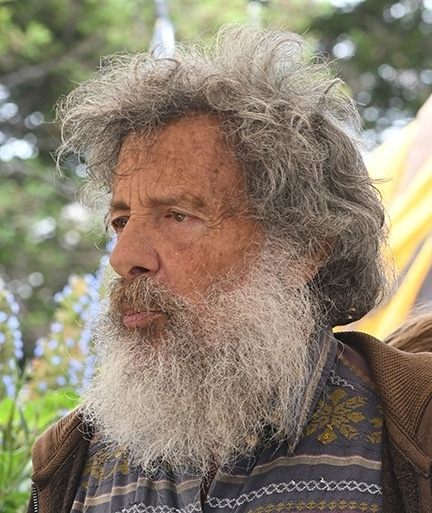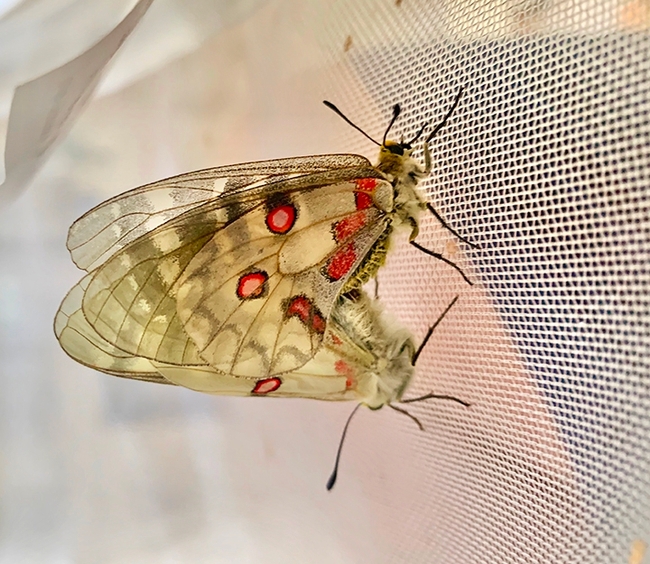
The cold-adapted Parnassian butterflies don't get nearly as much attention as the iconic monarchs that migrate to overwintering spots, but a UC Davis entomology student's research may help change all that.
Gary Ge, a member of the UC Davis Research Scholars Program in Insect Biology (RSPIB) who studies with Professor Louie Yang of the Department of Entomology and Nematology and UC Davis Distinguished Professor Art Shapiro of the Department of Evolution and Ecology, is using the American Apollo butterfly (Parnassius clodius) as a model to study how microclimatic conditions affect cold-adapted insects.
P. clodius, a white butterfly, is found at high elevations in western United States (Washington, Oregon, Nevada and Canada) and in British Columbia, Canada.
“Parnassians are a group of cold-adapted Northern Hemisphere butterflies that are becoming increasingly important as objects of physiological, ecological and evolutionary study,” said Shapiro, who has monitored butterfly populations across central California for the last 50 years. “They are only likely to grow more important in the context of climate change. Thus, Gary's study is very timely and should attract plenty of attention! It is demanding given the rigorous conditions in which they breed and develop, and he is likely to learn a lot that will facilitate future lab and field studies.”
Yang, who researches monarch butterflies and milkweed phenology, said: “Gary is a remarkable student with an excellent understanding of the butterflies he is studying. Over the years, he has applied his longstanding enthusiasm for these butterflies to ask insightful questions about the thermal ecology of cold-adapted organisms under global warming. Gary has also demonstrated the determination and resilience required to overcome unexpected barriers and to see his research through to completion. He is a skilled and thoughtful scientist with the ability to make valuable contributions to ecology, and I've been happy to have had a chance to work with him.”

Ge said he is testing this hypothesis “partly by looking at the supercooling points (SCPs) of diapausing eggs in different populations. The SCP indicates the freezing temperature of the egg, so it should be close to the lower lethal temperature. So, the population with the lowest average SCP would be the most cold-tolerant. I got some preliminary results recently indicating the SCP of the mid-elevation eggs is around -30 °C, which is pretty cold! On the side I am also testing the egg SCP of a Parnassius behrii population. This is a California endemic. It would be cool to see how their thermal tolerance differ from that of P. clodius as P. behrii is only found in high-elevation habitats (mostly around and above 9,000 feet).”
“The genus Parnassius is prone to global warming due to its affinity for alpine and arctic habitats, and several species are considered to be threatened,” Ge wrote in his proposal.
In his proposal, Ge points out that “The American Apollo has habitats ranging from coastal forests to above the tree line. Thus, they experience very different combinations of microclimatic variations depending on time and location. Unlike most other butterflies, their larvae develop under cold macroclimatic temperatures and demonstrate active behavioral thermoregulation. This makes them highly dependent and consequently sensitive to microclimatic temperatures. In addition, the adults are poor dispersers, limiting gene flow between spatially close populations. Their larvae are also likely the sole insect herbivore of the hostplant species, thus microhabitat identification is easy in the field.”

“Higher-altitude specimens are consistently smaller than at Washington and Lang,” Shapiro writes. “The male of this species generates a large waxy vaginal plug (the sphragis) that prevents the female from mating again (though other males do try). It does not, of course, interfere with egg-laying! Both sexes visit Yerba Santa, Coyotemint, and a wide variety of other flowers. At lower elevations this is a typical species of cool, mesic mixed forest, often along streamsides and at the bases of cliffs. At higher elevations it occurs in moist conifer forest and along streams and the edges of meadows. It does not hilltop. One brood, May-June (low) and June-August (rarely later) (high). Larval host plant Bleeding Heart, genus Dicentra (Fumariaceae, now put in Papaveraceae). Larvae are crepuscular-nocturnal except on cloudy, cool days and mimic poisonous millipedes.”
Ge traces his interest in insects to “a pretty young age. I can't say certainly what sparked my passion for them, but if I have to say one it was when I first brought some Xuthus swallowtail (Papilio xuthus) caterpillars to adults. At some point during elementary school, I found several Xuthus larvae on my backyard Zanthozylum tree, brought them back indoors, fed them and got to see them pupate and turn into butterflies. It is cliché but nonetheless true for me! From then on, I just kept noticing more and more of these amazing creatures around me. I have always loved to rear and breed insects instead of just collecting them, which set the foundation for my passion in insect ecology.”
Ge, born in Beijing, China, attended elementary school in New York City, middle school in Singapore, and high school in Hawaii, and now California for college. “This allowed me to have experience with a range of lepidopterans and ants and termites as well—social insects are my other favorite group.”
He developed his passion for Parnassius during middle school. “When I was visiting my extended family in Tibet, I saw this small white butterfly flying through the seemingly lifeless alpine scree habitat at an elevation of around 1,5000 feet. I later found out that it was a Parnassius species and got immediately intrigued by the fact that they are mostly specialist of alpine and arctic habitats, living in some of the world's coldest and most hostile environments. Since many of the genus members have habitats restricted to mountain tops above the tree line, our P. behrii is an example, climate change--rising tree lines-would leave them nowhere to go. This makes better understanding the ecology of this genus utterly important.”
At UC Davis, Ge serves as a research assistant with Shapiro's Central California Butterfly Population and Diversity Trends Study. He works with Yang as a project manager and a research assistant on his Milkweed Phenology Study.
As a prospective graduate student at UC Davis, Ge hopes to engage in outreach opportunities. One would be to set up an entomology exhibit at Briggs Hall during the UC Davis Picnic Day, which draws some 75,000 visitors to the campus. He also plans to join the STEM Squad, an after-school science program that introduces middle schoolers to different STEM fields. “I plan to spark students' interest in entomology and ecology by organizing a butterfly thermal ecology workshop, which will not only give students hands-on experience with insectarium management,” he commented, “but also raise their awareness of the impacts and complexity of climate change.”
Attached Images:
